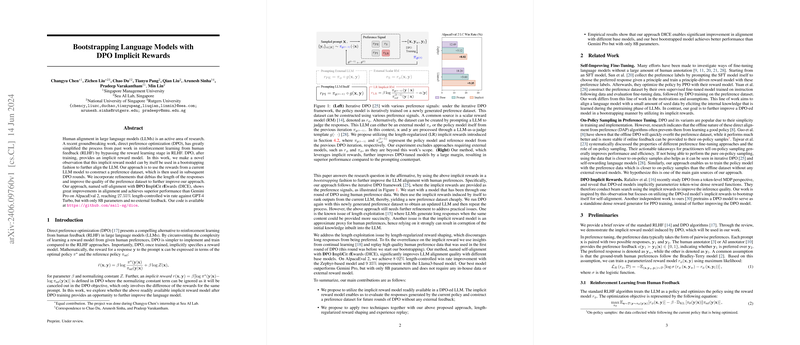An Analysis of Bootstrapping LLMs with DPO Implicit Rewards
The paper "Bootstrapping LLMs with DPO Implicit Rewards" presents an innovative approach to enhancing LLMs through the utilization of implicit rewards derived from Direct Preference Optimization (DPO). The primary aim is to improve LLM alignment with human preferences more efficiently compared to traditional reinforcement learning from human feedback (RLHF) methodologies.
Methodological Details
The authors propose a technique termed DICE (self-alignment with DPO ImpliCit rEwards) which employs an implicit reward model generated after the initial DPO process. This implicit model allows the LLM to evaluate its responses, creating a preference dataset for further rounds of DPO without requiring additional external feedback. This circumventing of the requirement for human feedback addresses cost and scalability challenges often associated with RLHF.
The paper reveals a methodology where, after primary DPO training on human preference data, the LLM uses generated implicit rewards to continually refine its responses. This process is iteratively repeated to facilitate continuous self-improvement of the LLM's alignment quality. Notable refinements in the DICE approach include the use of length-regularized reward shaping to counteract the issue of length bias in response generation—a known limitation where longer responses are favored despite their quality.
Empirical Findings
Empirical evaluation demonstrates significant enhancements in model performance. For instance, on the AlpacaEval 2 benchmark, DICE demonstrates an 8.02% improvement for the Zephyr-based model and a 9.35% enhancement for the Llama3-based model, delivering noteworthy results compared to existing methods like Gemini Pro, even at a parameter scale limited to 8 billion. Remarkably, these achievements were realizable without the integration of external reward models or additional feedback mechanisms beyond the initial dataset used for DPO training.
Theoretical and Practical Implications
Theoretically, the findings underscore the viability of leveraging implicit rewards derived during DPO as a sufficient substitute for external evaluation models in achieving robust LLM alignment. This raises possibilities for developing more resource-effective training protocols that still maintain alignment quality with human expectations. Practically, this method can significantly reduce reliance on extensive human-annotated datasets, thus optimizing alignment costs and expanding the potential for LLM deployment across various applications.
This work also hints at future explorations into on-policy sampling methodologies and further optimizing direct preference tuning by blending offline and online data, thus potentially overcoming limitations in static dataset approaches.
Challenges and Future Directions
While the implicit reward mechanism offers a promising alternative, the reliance on initial DPO quality remains a fundamental limitation—underscoring the necessity of robustly trained initial models to avoid potential performance degradation. Additionally, ensuring continual gains beyond two or three iterations remains challenging and is an area earmarked for future investigation.
Furthermore, ensuring ethical deployment and mitigating potential misuse form key components of broader considerations, given the model's enhanced propensity to serve alignment objectives more expeditively.
Conclusion
The manuscript presents substantial contributions to the field of LLM alignment, showcasing that implicit rewards can be effectively harnessed to bootstrap LLMs towards greater preference alignment. DICE establishes a pathway for efficient alignment without the onerous requirements of extensive external feedback, marking a pivotal conversation in the pursuit of more autonomous LLMs that efficiently integrate human-aligned behaviors at a reduced computational footprint.
The paper sets the stage for future scholarly discourse and empirical testing focused on enhancing the feedback loop between LLM evolution and implicit rewards, potentially leading to transformative approaches in AI alignment methodologies. Overall, this work offers a substantial contribution to ongoing research into optimizing LLM performance through internal self-improvement mechanisms.
